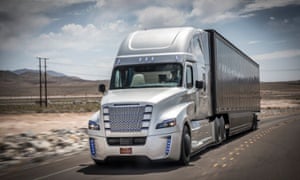Results 1 to 1 of 1
Thread Information
Users Browsing this Thread
There are currently 1 users browsing this thread. (0 members and 1 guests)
-
05-06-2015, 03:38 PM #1
Nevada clears self-driving 18-wheeler for testing on public roads
Self-driving cars
Nevada clears self-driving 18-wheeler for testing on public roads
Daimler’s Inspiration big rig certified for use in state whose ‘huge stretches of empty, government-owned land’ make an ideal proving ground

Daimler’s self-driving Inspiration big rig reads road markings and alerts the driver when it will be unable to complete a maneuver. Photograph: Daimler
Sam Thielman in New York
@samthielman
Wednesday 6 May 2015 14.24 EDT
Last modified on Wednesday 6 May 201515.15 EDT
Drone trucks could soon be plying US highways after Nevada authorities on Wednesday granted a license to test self-driving trucks on public roads.
While companies such as Google and luxury brands like Lexus have dominated the headlines with advances in driverless cars, Daimler board member Wolfgang Bernhard told reporters autonomous trucks were likely to hit the roads first.
Daimler’s 18-wheel Inspiration has now been certified for use on public roads in the state, and yesterday the non-human (well, less-human) big rig rolled out across the Hoover Dam, negotiating some (but not all) turns and twists all by itself. For the tougher curves, it had some help from a driver inside the cab.
Google’s own automated car is also licensed for use in Nevada; both the Daimler truck and the Google car are authorized for use under Nevada’s autonomous driving law, which “requires that drivers obtain a special endorsement on their driver’s licenses” according to the National Highway Traffic Safety Administration.
Bernhard told reporters in Las Vegas that because trucks operate in “a less complicated traffic environment” they were ideal starting points for the coming automated vehicle market. But the real economic value of the invention, he said, would come when not just Nevada but other contiguous states license the vehicles, enabling trucking companies to use them to transport goods across long distances.
The licensing process was a lengthy one, said a Nevada department of motor vehicles spokesman, David Sierro. “I’m just getting out of the truck now,” he told the Guardian. “You’re talking about a series of different technologies; crash avoidance, blindsight, camera technology,” he said. “Rather than being a single autonomous [device] it’s a series of technologies they’re developing. They’re building it in an incremental way.”
Sierro said Daimler tested the truck on areas like the Las Vegas Motor Speedway, where the trucks could read pavement markings without endangering other drivers or pedestrians. “It’s fascinating to see how it’s reading the lines,” Sierro said. “When there’s something [too complex for the autopilot] coming up, there’s a warning that lets the driver know he’s going to have to take over.”
Tony Illia, of the Nevada department of transportation, said the state gave Daimler the option to start out simply. “There are huge stretches of empty, government-owned land [in Nevada],” he said. “Our population is centered in the Reno area and the Las Vegas area”, so trucks going between the two mostly have to navigate long straightaways. Daimler had a request of the Nevada government, too: “The one thing [Daimler] did ask was to brighten up the lane-striping and the buttons, to make sure they were clean and bright,” Illia said. “I think that helps the cameras on the truck.”
Still, there’s a lot more to be done before the truck makes any deliveries.
Simonette Illi, a spokeswoman for Daimler, told the Guardian that the trucks should be available for purchase “from the middle of the coming decade (around 2025)” and that it’s important to have it available “at an attractive price”.
“We consider a payback period of 18 to 24 months for our customers when the new technology goes into production,” she wrote.
Companies like Lowell, Arkansas-based JB Hunt have reported a driver shortage across the country and are looking at consolidation in order to meet demand. The company is also worried about changing emissions standards for Class 8 trucks (that’s the class of truck demoed today, which Daimler says is more efficient), so a vehicle with a driver who has to do less work, or requires no driver at all, could provide companies like Hunt with a cost savings on labor.
A spokeswoman for JB Hunt declined to comment for this story.
http://www.theguardian.com/technology/2015/may/06/nevada-self-driving-trucks-public-roads-daimler-inspirationNO AMNESTY
Don't reward the criminal actions of millions of illegal aliens by giving them citizenship.
Sign in and post comments here.
Please support our fight against illegal immigration by joining ALIPAC's email alerts here https://eepurl.com/cktGTn
Similar Threads
-
Filing for new driving card risky for some Nevada immigrants
By JohnDoe2 in forum illegal immigration News Stories & ReportsReplies: 0Last Post: 12-18-2013, 02:08 PM -
Bureau of Land Management RACES TO CLOSE PUBLIC ROADS & LANDS
By AirborneSapper7 in forum Other Topics News and IssuesReplies: 0Last Post: 06-09-2012, 03:34 AM -
GA- Bill to bar illegal immigrants in public colleges clears
By topsecret10 in forum illegal immigration News Stories & ReportsReplies: 3Last Post: 02-16-2011, 12:23 AM -
TX: Immigrants rescued from 18-wheeler in Raymondville
By Jean in forum illegal immigration News Stories & ReportsReplies: 0Last Post: 11-11-2008, 02:00 AM -
TX: $1 million cash discovered in 18-wheeler
By Jean in forum illegal immigration News Stories & ReportsReplies: 3Last Post: 01-27-2008, 01:59 PM


 LinkBack URL
LinkBack URL About LinkBacks
About LinkBacks




 Reply With Quote
Reply With Quote


Listen to William Gheen on Rense Apr 24, 2024 talking Invasion...
04-25-2024, 02:03 PM in ALIPAC In The News